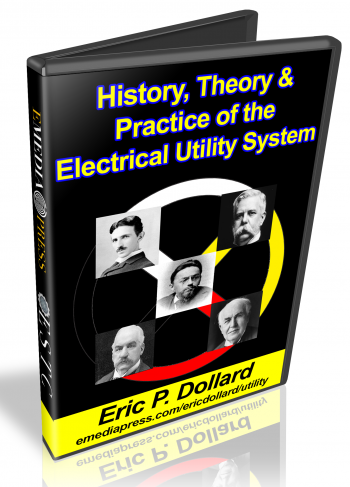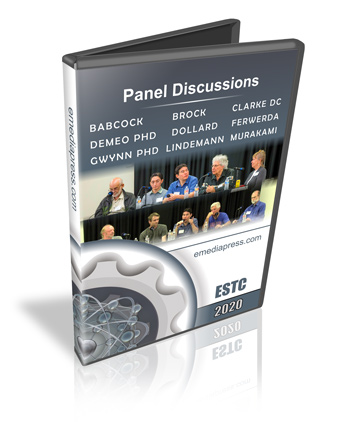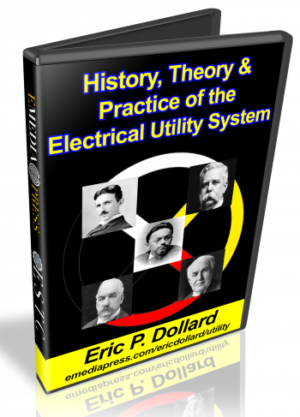Description
(1) INTRODUCTION
Presently, much discussion exists regarding the proliferation of harmonics in the electric utility system. Moreover, the susceptibility of this system to damage or destruction from a well-positioned nuclear E.M.P. is a subject of great concern.
Such problems are not necessarily intrinsic to the process of electric transmission and distribution, but only present themselves when certain configurations exist within the electric utility system. Paramount in any transmission or distribution system is that such system must be a closed system, that is, the electromagnetic boundary condition must be maintained to the highest practical degree. This assures that the entry or exit of extraneous electric forces is minimized.
Presently, with regard to the electric utility system, the electromagnetic boundary condition is being violated in two ways;
1) By the ubiquitous employment of Wye to Wye connected transmission and distribution transformers, and related load configuration.
2) Through the extension of a common neutral connection throughout the entire electric utility system.
The widespread and enforced adoption of these practices has rendered the electric utility system an open system, or in other words, an antenna system, one of unprecedented proportions. The consequences must be obvious.
It is the objective of the following series of engineering reports to re-establish a fundamental understanding of polyphase alternating current, then apply this understanding to the analysis of the situation as it exists today with regard to the electric utility system.
(2) THE ENGINEERING DILEMMA
Electrical engineering in the digital age has taken a turn into the abyss. The engineering foundation so well established through the efforts of Arthur Kennelly, Charles Steinmetz, and other notables, has been outright abandoned. Engineers have been replaced by software technicians, and accordingly the electric utility system has become a morass of harmonics, parasitic oscillations, and stray currents. This malady is presently being carried out with deliberation, and moreover, being made law.
(3) THE SITUATION, THEN AND NOW
Kennelly once remarked that a properly designed three phase power system contains no significant harmonics. This may have been true in the era in which Kennelly lived, but presently the proliferation of harmonics in the electric utility system is rampant. In the manner of Oliver Heaviside, one may ask; If harmonics are a problem, then why allow them to begin with. The child exclaims, “The Emperor wears no clothes”!
In the early electrical age, the principal customer loads were the incandescent lamp of Thomas Edison, and the induction motor of Nicola Tesla. Neither were a source of significant harmonics. What harmonic content did exist was neutralized by the Delta connection of apparatus windings.
The concurrent development of long distance telephone served as a check upon the harmonic content of the electric utility system. In this era the long lines were of open wire construction and utilized voice frequency transmission, both of which are susceptible to power system interference. This situation led to the establishment of an administrative agency to co-ordinate electromagnetic compatibility between power and communication companies.
(4) THE GENESIS OF THE “HARMONIC PROBLEM”
Two principal factors led to the harmonic situation as it exists today in the electric utility system. One was the gradual adoption of a Wye connection of apparatus windings and load configurations, another was the increasing use of fluorescent lighting as a replacement for incandescent lighting.
The general use of a Wye connected transformer configuration grew out of the need to expand the load capacity of existing distribution systems to meet the ever-increasing demand for electric light and power. Delta to Wye system conversion allowed for a 173 percent increase in capacity while retaining the original transformers. The only additional requirement in this conversion is the system-wide installation of a fourth conductor, or system neutral. An additional benefit derived from the neutral was that the system could be referenced to Earth potential without the need for auxiliary apparatus, as was necessary in a Delta connected system.
The dominance of the Wye connected load grew out of the proliferation of large office complexes. The enormity of their lighting systems required a shift from the Edison three wire system to a Wye connected four wire configuration, this in order to provide a good phase balance to the electric utility providing the power for illumination. A significant penalty for this conversion is that while the Edison system suppresses the harmonics, the Wye system reinforces the harmonics.
The large-scale generation of harmonics began when the fluorescent lamp replaced the incandescent lamp in these large office complexes. The fluorescent lamp and its reactance ballast are a prodigious source of troublesome harmonics. Ultimately such a load should be Delta connected in order to suppress the proliferation of these harmonics into the electric utility system. However, such connection requires two pole rather than one pole switching and circuit protection devices, which increases the cost of installation.
In the electric age the primary windings of the distribution transformers supplying electric power to these lighting systems were typically Delta connected. This prevented entry of the harmonics into the electric utility system. The penalty was to be increased transformer heating.
(5) WYE CONNECTION OF TRANSMISSION SYSTEMS
The widespread adoption of Wye connected electric utility systems can be attributed to the efforts of the rural electrification administration, R.E.A. Here the objective was to significantly reduce the cost of delivering electric power to the more remote areas of the United States. Through the employment of the higher transmission voltages for the purpose of distribution, the “copper” cost was greatly reduced. Because no transformer was required to step down this transmission voltage to a distribution voltage, the cost of a distribution substation was obviated. The penalty for this practice was that the transmission system must also be Wye connected.
Another cost savings measure adopted by the R.E.A. program was the implementation of a multiple grounded neutral throughout the entire system. This neutral was made common to both the high side and low side of the distribution transformer, effectively bypassing the transformer. This practice significantly reduced the insulation requirements on an otherwise high voltage system. The penalty for this practice is the exposure of the customer to primary neutral transients, and difficulty in ground fault protection.
The practices instituted by the R.E.A. program significantly enhanced the ability of the resulting electric utility system to interfere with other services. Inevitably, what saved the power company money cost the phone company money, and endangered the customer.
(6) THE ELECTRIC UTILITY IN THE ELECTRONIC AGE
As society moved from the electrical age into the electronic age the situation of the electric utility system began to deteriorate. In the electronic age an ever-increasing proportion of the load presented to the electric utility system was to involve the conversion between the alternating current used for light and power and the direct current used for electronic devices. The conversion between A.C. and D.C., rectifiers and inverters, is verily a condition of “forcing a square peg into a round hole”. Accordingly, this process engenders a plurality of troublesome transients, particularly those associated with the silicon-controlled rectifier (S.C.R.), which ultimately spelled disaster for the electric utility system.
The harmonic malady was propelled forward by a shift in reasoning, this from the established viewpoint of electric transmission as an electromagnetic boundary condition (Maxwell-Heaviside), to the modernistic viewpoint of electric transmission as an electronic current (Lorentz-Einstein). In the modern viewpoint electricity was no longer propagation in the space enclosed by the transmission conductors, but the notion is that electricity is propagated within the transmission conductors themselves. Accordingly, in this view, the space surrounding the transmission conductors is void of any electrical activity. This mindset has made impossible any understanding of electric transmission and has sent electrical engineering back into its dark ages when electricity was regarded as a material substance.
(7) THE ELECTRIC UTILITY IN THE DIGITAL AGE
The electric utility in the digital age has arrived at a situation where all deleterious factors have merged into a common motive. Nicola Tesla would say “Commercial Enterprise has out-run technical competence”.
The vanguard is the ubiquitous eradication of the Delta connection of apparatus windings and load configurations. The entire electric utility system is undergoing a retrograde conversion, from what was an interlocked triple phase system, into a trio of independent singe phase systems. Moreover, the primary and secondary windings of all transmission and distribution transformers are being bonded together at their neutral points. This effort effectively bypasses the transformers, hence creating an extensive metallic pathway for the propagation of harmonics, oscillations, and disruptive transients.
In this digital age the load presented to the electric utility system is of a disruptive discharge nature. All contemporary power conversion methodologies employ the integration of switching transients in the conversion process between the utility system alternating current and the electronic (silicon) device direct current. In general, a true A.C. load is becoming non-existent.
It is the intrinsic nature of such transient waveforms to excite oscillations into the electric field surrounding the various transmission and distribution structures. These in turn intensify the already problematic harmonic waveforms. Moreover, the interaction of these electric oscillations with the semi-conductor devices results in a barrage of spurious frequencies. The plurality of these parasitic oscillations tend to merge into a unified oscillation through the common neutral connection, giving the ability to distribute interference on an unprecedented level. This situation alludes to electronic warfare, where consumer devices of foreign manufacture can be regarded as a “Trojan Horse”.
It has become evident to many that the aforementioned condition has created an unprecedented level of radio interference, particularly in the A.M. broadcast band. However, unlike the era of long distance telephone, no administrative agency exists to ensure electromagnetic compatibility in this digital age.
(8) EPILOGUE
It is important to recognize that the ultimate root of the problem here defined is sociological, not technological. The situation today resembles in many ways that which existed at the onset of the dark ages, when the first theory of relatively announced that the Earth is the centre of the universe, a notion brutally enforced by the corporate church.
Accordingly, any attempt toward re-mediation of the electric utility situation will be met with fierce opposition and nothing will change for the better. Such is the fate of the human species, it is written.
Part of the 2018 Energy Science & Technology Conference series (5 hours downloadable video).









Reviews
There are no reviews yet.